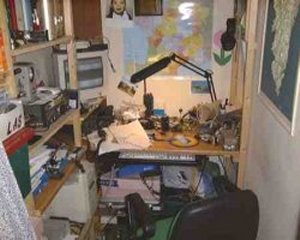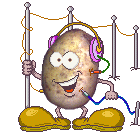 If you are looking for some informations about my radioamateur carrier, you're on the right page. If you want to learn more about myself, my family, you should better go on Ma famille
If you are looking for some informations about my radioamateur carrier, you're on the right page. If you want to learn more about myself, my family, you should better go on Ma famille
How all started :
Already very early, i have been interested in radio technics. I was 14 when i build my first receiver. I remember that i found in a book for kids, among some simple chemical experiments, a method for building a boomerang, the way to build a simple radio receiver.
It described how to make it with a potato, an earphone and some copper wire. Later i learned that the potato was the detector. Cut it in two and let oxidation do the rest ! What i thrill to listen to some broadcast stations on a earphone taken from an old telephone !
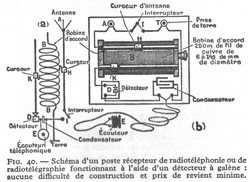 The next step was to replace the potato with a Germanium diode (at that time they were packed individualy in small cardboard boxes), and to add a coil wound around a toilet paper roll . The result was a much louder audio, so loud that i could listen to it with the earphone on the table !! Even my father was impressed and listened with me !
The next step was to replace the potato with a Germanium diode (at that time they were packed individualy in small cardboard boxes), and to add a coil wound around a toilet paper roll . The result was a much louder audio, so loud that i could listen to it with the earphone on the table !! Even my father was impressed and listened with me !
La station la plus puissante reçue à l'époque était RTL. Le soir venu, d'autres apparaissaient et se mélangaient un peu, mais peu importe ! Quel plaisir d'écouter la radio sans pile caché sous ses draps...
Here the "diagram" of the receiver built in 1969
From there, i listened to everything i could on my parents large broadcast receiver. One day i heard some strange people talking together in a unknown language. I looked on the dial and found 14 Mhz SW, i was listening to my first amateur conversation, it was in AM and they called that a QSO ?! I later learned that they were living in the same town as me and that my father recognized the voice of one of them... I listened to them every sunday morning, but one day one of them was completely unreadable, a real garbage... he was simply the first to use SSB with a HW32 from HEATHKIT.
I asked my father if he could drive me to the guy he knew, and a saturday morning i met my first amateur : F2GX Gérard. He showed me his station and made me some demonstrations. I was realy impressed and asked him if i could come back. That's the begining of my "radioactivity". From there, everything went quickly !
With his help and others, i started to build my first REAL receivers. The first one was a down converter made with 2 tubes which i hooked to a small transistor AM MW receiver. Than some reaction receivers (you know the "waterfall" noise you MUST hear ?) which turned out to be also good transmitters when you turn the feedback a little too much.!
The next step was to build a small transmitter with some old US SIGNAL CORPS crystals ref. FT243, one valve and a carbon microphone. It was working but the "locals" told me that i was not allowed to transmit
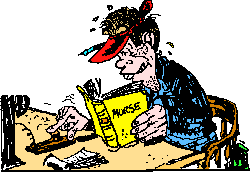
ME : Not allowed ? That's new ! What do i have to do to be allowed ?
HIM : Hey, easy ! Pass your exam and that's it ! But, you must wait until you are 18.
ME: Eighteen, but that's very late !
HIM : Well, you can use this time to learn the morse code.
ME : Morse code ? What's that ?
HIM : Listen, he said, while turning his VFO on a CW station.
ME : I hear only noise !
HIM : No, boy, that's MUSIC !
So, i knew what to do and learned the code by taking the letters from the dictionary and listening to the MARINE and HAM bands. Later, i met a retired CW operator, Robert.
Bob also wanted to get his ticket. He did'nt knew a lot about technics and proposed me a cooperation. He would learn me the code and i would learn him as much as i knew (not much at that time). So, every saturday afternoon i took my bicycle and went to the next town to his house. This cooperation has been very profitable for each of us, we learned a lot from books and the local amateurs and i learned morse code rather quickly.
Every saturday, was it raining or not, i took my bicycle and covered the few miles to visit him and we learned hard. This cooperation turned out to be very efficient and we both felt ready to try to pass the exam.
But, there is always a BUT when you're are young ! I've forgoten one thing ..... my parents ! "Boy, you must get your school examinations first !" So, several other years passed and finaly, we both got our ticket with success at first time. I received my callsign a few days before i went to the army for my military service, i was F6EQG and Robert F6EQF. Before that, i already had made several hundreeds of QSOs with a F2.. callsign which was not used. But, pssss !!
Thank you for all, Gérard, Robert, Charles and all others !!
So, my callsign in pocket, i had to leave home and go to the army... I was very lucky to be sent in a French oversea territory called "Ile de la Réunion" in the Indian ocean. What a shock !! It was so different from what i knew ! I immediately asked for a FR callsign and got FR0DCK. Unfortunately, i was not allowed to transmit from the barracks ! So i looked for a club station from where i could transmit... Murphy knocked again, no clubs in Saint Denis de la Réunion ! But i met some local hams and could transmit a bit from their stations, but it was unconfortable ! The President of the local radioamateur association FR7BT asked me if i would help him to create a club. So we quickly did that, and i build a kit from HEATHKIT, the good old HW101. We put a 20m dipole and i was a little more active, but i never could have a serious activity.
Back in France in 1978, i got my F6EQG callsign again and continued my activity until 1984. I build some equipment, including a 2m amplifier using a 4CX250B and was more active on 2m. I also participated to several V/UHF contests with good results. The highlight was a very nice score in mono-op category during the Marconi CW contest on 144Mhz in 1983 (1st France and 4th Europe). I was also hunting the DXCC on HF and got more than 300 countries but never asked for any appliance.
In 1984, i came to Corsica where i'm still living and another ham live began. After being several years a hunter i became the fox and that was much funnier !! I made a lot of V/UHF contests in mono-op as well as multi-op category with good results, but i quickly reached the maximum of what can be done from here on these bands.
I than tried HF contests and started with some friends we took part in our national championship, and we had a lot of fun. Some times later, F6BBJ asked me if it would be possible to make a WPX contest from Corsica, i immediately agreed. That was the start of a new passion, HF contesting.
In the meantime, my old friend F2DX (ex F6EYS) who i left some years before in Strasbourg, came to Corsica after a 2 years stay in Saint Pierre and Miquelon where he was FP5DX. He got his TK5NN callsign soon after his arrival. We found that we had the same interests in contesting, so we decided to engage the next gear. At first, we looked for a better QTH than our home stations which were downtown.
Jacques TK5BF was so kind to lend us his antennas and a part of his garden, so we decided to make a try. The success was immediate, and after 2 years we could even beat the "unbeatables" which were glued at the top place since many years ! From there, we had a long list of successes and we gradualy improved our contest station and even found a better QTH from where we could setup a competitive low band station to fight against the low sun spot. This spot is called "Marina di Capitello".
This QTH was a real dream for us, large flat fields, no neightbours and plenty of rooms where to sleep and operate ! We will never thank Peter and his wife enough for their kindness.
Thanks to Dieter DF4RD, we came in touch with the BCC (Bavarian Contest Club) and with their help we made a lot of very nice multi-multi contests under TK1A, TK2C, TK5NN. Always top scores and top FUN !! Thanks for all, boys !
Even if i think that contests are games to play with a team, i also made some mono-op contests on HF with following results :
- First place world mono-assisted 160m in CQWW 1996 with new world record.
- French champion SSB/CW mono-op several years in a row with new record.
- First european in the 10m ARRL contest 1998.
- 1st EU and second WW in mono-op mixed in 10m ARRL.
I've always been interested in radio technics and i've build all kinds of equipments, receivers, transmitters, amplifiers, antennas and all what you can find in a ham station. Soon after my arriving here in Corsica, i've been interested by the activity of the local radio-club TK0KP in Ajaccio. I helped as much as i could the responsibles of the club, Marcel TK5CJ and Serge TK5ET, in maintaining the local repeaters.
Some times later, i met Francis TK3FB which was also very interested in radio technics and homebrewing and we decided to build a new VHF repeater. Francis build the logical part and the power supply, while i was building the radios. We finaly could make the repeater work and it has made a nice job for years without any failure. Just after that we also rebuild the UHF repeater for which i build a duplexer. It is still working.
When packet radio appeared in Europe i was immediately interested in this new mode, and we quickly became qrv with the first version of TNC made by the TAPR group. It was very uncomfortable but we could make some contacts and use the digi i built on a mountain. Even with a poor net, we could contact all France and make some keyboard to keyboard qso. Soon after, with the help of TK3LO we started our first bbs.
Now, we have a nice node using the RMNC/Flexnet base. It works trouble free since years and we have stable and fast links to almost all central Europe.
Nowadays
My station at home is very modest compared to what i've used several years ago, i'm searching for a new home and don't want to put much time and money in this one... I have very little space for my station, and can't even put my amplifiers in it !
Somewhere, i have a lot of aluminium, amplifiers for HF and VHF (home build), VHF SSB transceiver etc... which i hope i can use at home one day. But here, i have only the following equipment :
On HF :
TS850s with Windom FD4 multiband antenna.
On V/UHF :
IC2400A inn FM with COMET duo-band antenna.
Computer :
DELL Dimension 9150, DELL photo 924 printer
Other modes :
I'm qrv in most digital modes with the soundcard and various softwares.
On the right, my station a very ordinary day... As you can notice, all is very tidy !!
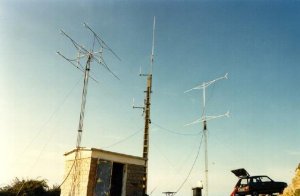
From time to time i climb on a moutain top called "La Punta" close to my city, where we have our packet node and UHF repeater.
I use this qth to be qrv on V/UHF for contest, meteor scatter, EME etc....
It's not the best QTH via DXing on these bands on Corsica, but it's convenient because we have main supply and a nice road to reach it ! It's 790m asl.
On VHF i use a homebuilt high performance transverter + the TS850s with a home made 4CX250B amplifier, anennas varying from a single 7el to a 4x16el.
On UHF i use a home made transverter with the TS850s andt 100W in one to four 21el yagis.
This picture shows this QTH while used during a V/UHF contest.
VHF activity:
Even if im' a bit less active on VHF/UHF than several years ago, i like to climb on mountain tops to make some trop, meteorscatter qso and contests. I've been active in many contests and the highlight was the first european place during the BCC meteor scatter contest in 199? with my friend F5HRY.
To achieve better results during contests, i don't hesitate to move in the extreme northern part of Corsica, named Cap Corse in JN42QX from where it is much easier to reach the high activity zones in Europe.
I don't keep track of my scores, but i have more than 50 countries worked on VHF, see this map (55Kb), without never trying to collect squares or cards. My biggest fun is to help people to work Corsica and our rare squares.
Since 2006, i'm also active on 3cm with 250mW and a75cm offset dish. That's also a lot of un !
HF Activity :
On HF, i'm mostly active during contests and even more in CW. From home with simple antennas, i worked 313 DXCC entities, but due to time lack or low interest, i missed a lot of rare expeditions...
As technology improves i'm also active in all digital modes digitaux, SSTV, AMTOR, PACTOR, PSK31, FELDHELL etc....
Home made :
I like a lot building my own equipment, and year after year i collected some test equipment :
- Tektronix 2710 spectrum analyser from 10 kHz to 1,8 GHz.
- Communication service monitor IFR 2945a from 400 kHz to 1.05 GHz.
- Hameg HM203-7 dual trace scope.
- Racal 9915 frequency counter.
- Metrix 761 0-30V, 0-4A METRIX power supply.
- Palomar noise bridge.
- 0-30 MHz antenna analyser after VK5JST
- 2 tone generator described on this site
- LC meter (described on this this site)
- 10 MHZ GPS locked reference.
- 10 MHz home made Rubidium frequency standard (10 ,5, 1 MHz)
- Digital multimeter.
- Different homemade couplers, probes.
- VNWA by DG8SAQ,
- etc...


